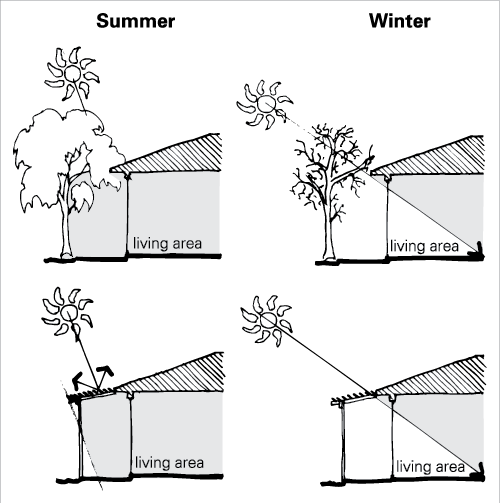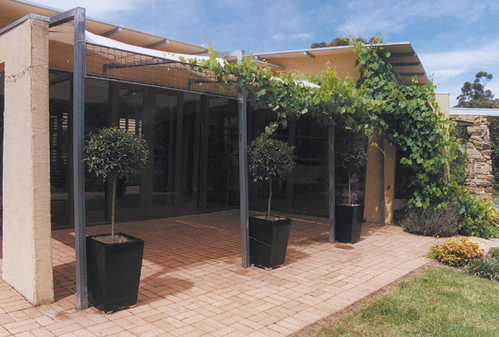Shading glass is the best way to reduce unwanted heat gain, as unprotected glass is often the greatest source of heat entering a home. However, fixed shading that is inappropriately designed can block winter sun, while extensive summer shading can reduce incoming daylight, increasing the use of artificial lighting. Shading uninsulated and dark coloured walls can also reduce the heat load on a building.
Radiant heat from the sun passes through glass and is absorbed by building elements and furnishings, which then re-radiate it inside the dwelling. Re-radiated heat has a longer wavelength and cannot pass back out through the glass as easily. In most climates, ‘trapping’ radiant heat is desirable for winter heating but must be avoided in summer.
Shading of wall and roof surfaces is therefore important to reduce summer heat gain, particularly if they are dark coloured or heavyweight. Light coloured roofs can reflect up to 70% of summer heat gain.
Solar radiation is re-radiated inside.
| Orientation | Suggested shading type |
|---|---|
| North | Fixed or adjustable horizontal shading above window and extending past it each side |
| East and west | Fixed or adjustable vertical louvres or blades; deep verandas or pergolas with deciduous vines |
| NE and NW | Adjustable shading or pergolas with deciduous vines to allow solar heating or verandas to exclude it |
| SE and SW | Planting: deciduous in cool climates, evergreen in hot climates |
General guidelines for all climates
Use external shading devices over openings, such as wider eaves, window awnings and deep verandas or pergolas. Lighter-coloured shading devices reflect more heat, and those with light coloured undersides make better use of daylight than dark coloured. Internal shading does not prevent heat gain unless it is reflective: only shiny surfaces can reflect short wave radiation back through the glass without absorbing it.
To reduce unwanted glare and heat gain, use plants to shade the building, particularly windows. Evergreen plants are recommended for hot humid and some hot dry climates. For all other climates use deciduous vines or trees to the north, and deciduous or evergreen trees to the east and west.
External shading devices.
Within the range of north orientation that allows good passive sun control (20°W and 30°E of solar north) sun can be excluded in summer and admitted in winter using simple horizontal devices, including eaves and awnings. For situations where a good northerly orientation cannot be achieved (e.g. existing house, challenging site) it is still possible to find effective shading solutions (see Orientation and Passive solar heating).
North-facing openings (and south-facing ones above the tropic of Capricorn) receive higher angle sun in summer and therefore require narrower overhead shading devices than east or west-facing openings. Fixed horizontal shading above north-facing glazing is all that is required. Examples include eaves, awnings, and pergolas with louvres set to the correct angle (see ‘Fixed shading’ below).
East and west-facing openings require a different approach, as low angle morning and afternoon summer sun from these directions is more difficult to shade. Keep the area of glazing on the east and west orientations to a minimum where possible, still allowing for good cross-ventilation (see Passive cooling), or use appropriate shading devices. Adjustable shading, such as external blinds, is the optimum solution for these elevations.
Photo: QMBA/Your New Home Magazine
This deep veranda provides welcome shade but can admit very low angle sun.
Deep verandas, balconies or pergolas can be used to shade the eastern and western sides of the home, but may still admit very low angle summer sun. Use in combination with planting to filter unwanted sun. Wide verandas can reduce daylight unless carefully designed.
Photo: Sunpower Design
Plantings, deciduous vines, shade cloth and screens can all be used in conjunction with pergolas to provide seasonal shading.
Pergolas covered with deciduous vines provide self-adjusting seasonal shading. A gap between the wall and planted screens should be left for ventilation and cooling. Vines on walls or a trellis (where appropriate) can also provide summer insulation to all orientations. As evergreen vines block winter sun, they should only be used in tropical climates or on problematic west façades.
Use drought tolerant ground cover plants instead of paving where possible, to keep the temperature of the ground and surrounding surfaces lower in summer.
Protect skylights and roof glazing with external blinds or louvres. This is crucial as roof glazing receives almost twice as much heat as an unprotected west-facing window of the same area. Quite small skylights can deliver a lot of light, so be conservative when sizing them.
Position openable clerestory windows to face north, with overhanging eaves to exclude summer sun. Double glaze clerestory windows and skylights in cooler climates to prevent excessive heat loss.
Advanced glazing solutions can exclude up to 60% of heat compared to clear glass.
Advanced glazing solutions can exclude up to 60% of heat compared to clear glass, and are a useful secondary measure on east and west elevations. They should not be used as a substitute for shading in hotter climates because only effective shading can exclude 100% of direct solar heat gain. Insulative glazing (e.g. double glazing) reduces ambient (conducted) heat gains.
Measurements of heat gains in building elements such as walls, floors or roofs are expressed as U-values. U-values and solar heat gain coefficients (SHGC) are available for all glazing products and require careful selection (see Glazing). Use high SHGC glass on north-facing windows when you want to let in winter sun and low SHGC when you want to exclude it.
Low U-values (best performance) are desirable in cooler climates and hot climates where windows are kept closed, e.g. because of air conditioning or high external air temperatures (see Design for climate; Glazing).
Calculating sun angles
The angle of the sun in the sky at noon can be easily calculated for the solstices and equinoxes as follows:
- Equinox = 90° — latitude
- Summer solstice = Equinox + 23.5°
- Winter solstice = Equinox — 23.5°
The diagram for Darwin below shows why southern façades must be shaded in tropical locations to keep out the summer sun — buildings need to be able to be shaded all year round.
Calculating sun angles.
Many designers have computer aided drafting programs that calculate sun angles and shadows for various locations and topographies based on a digital site survey.
The Geoscience Australia website (www.ga.gov.au) allows you to find the latitude of more than 250,000 place names in Australia and calculate the sun angle at any time of the day, on any day of the year.







Comments are closed.